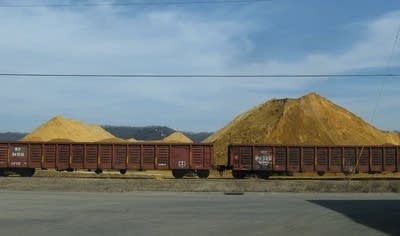Amish residents question mining activity in SE Minn.
Go Deeper.
Create an account or log in to save stories.
Like this?
Thanks for liking this story! We have added it to a list of your favorite stories.

ST. CHARLES, Minn. -- The rolling countryside near St. Charles is a place of horse-drawn buggies and one-room schoolhouses, woodworking shops and limited electricity.
Settled by 60 Amish families, it's a place of simple living, where farmers like Daniel Gingerich raise livestock.
Gingerich, a bishop in the isolated community, fears the burgeoning silica sand mining industry in southeastern Minnesota could harm their way of life.
"I wish the sand was 100 miles away," said Gingerich, 44.
Turn Up Your Support
MPR News helps you turn down the noise and build shared understanding. Turn up your support for this public resource and keep trusted journalism accessible to all.
In the mining industry, the silica sand beneath the bluffs of southeastern Minnesota and western Wisconsin is called "yellow gold." Strong and round, the tiny sand particles are extremely valuable, used to help extract oil and natural gas from the ground.
Local government officials are enacting rules to regulate the mines, washing facilities and transportation hubs that come with the fast-growing industry. But many worry that the operations will harm the environment.
About 10 miles from the cluster of Amish farms, Faribault-based Farm2Rail has proposed building a 300-acre rail yard that would serve as a transportation center for several active sand mines a few miles away.
That concerns Gingerich, who raises sheep, cows and chickens on his 111-acre farm. His life is simple and largely private. However, he has voiced his opposition to the rail yard at township meetings. Gingerich said transporting sand from nearby mines to the proposed rail facility -- by truck -- would dramatically affect the community.
"I'd say the biggest issue is safety issues, because we have horses and buggies on the road," he said. "They're talking a minimum of 400 to 800 trucks a day. Every minute or so, there'd be a truck going, and we have our schoolchildren on the road."
About 400 people live in the settlement, and many share his concerns about safety and transportation. But Gingerich said there's debate even within the Amish community over the mining of silica sand.
"I myself have got a letter from the sand mining [company] stating I have sand; they'd like to rent it or lease it or buy it," Gingerich said. "But there's probably some Amish that have it that are planning on mining it. For myself, I feel we can make it without."
Farm2Rail partner Ed Berens said the company is considering various ways to transport sand from the mines to the proposed rail yard, including using underground pipes or conveyor belts to move the sand. Berens said a company engineer has met with members of the Amish community. But he declined to elaborate about how the company plans to work with the settlement.
The rail project is subject to approval from Winona County officials.
Minnesota is home to 3,275 Amish people in 13 settlements, according to the Young Center for Anabaptist and Pietist Studies at Elizabethtown College.
The communities are clustered in Fillmore and Winona counties in southeastern Minnesota and Todd County in central Minnesota. There are other, smaller communities in Clearwater, Becker and Polk counties.
Lee Zook, an Amish expert and retired professor of sociology at Luther College in Decorah, Iowa, said the Amish lifestyle -- including the use of horses and buggies -- might seem like a novelty to outsiders. But he said increased truck traffic can create safety problems for Amish communities that are dependent on each other.
"Having a large industrial installment next to this kind of typical, idyllic kind of farming community is going to be extremely disruptive in terms of not only transportation but also just noise levels," he said.
Zook said the Amish teach humility and avoid actions that draw attention to themselves. They wear simple clothing, and avoid wearing cosmetics and jewelry or having their pictures taken as a way to prevent pride.
That's why he thinks it's a big deal that members of the St. Charles Amish community are voicing concerns publicly about the proposed rail facility.
"Many times, when they run into conflict with regulations and so forth, they end up resisting those on a very quiet basis rather than making any kind of protest," Zook said. "So for them to go to meetings and voice concerns about this is kind of an interesting way of -- kind of a change."
For Gingerich, the proposed sand transport facility is important enough for him to attend township meetings. He has been to public forums on other issues in the past but said he usually avoids public confrontations. "We're not here to make a big issue or fuss out of it," he said. "But if we see they want to put a pipeline in, we'd go along with that fine."
Winona County officials are expected to discuss the issue in the coming months. But it might be a while before Gingrich and other Amish families know exactly how the proposed rail facility will affect their community.




